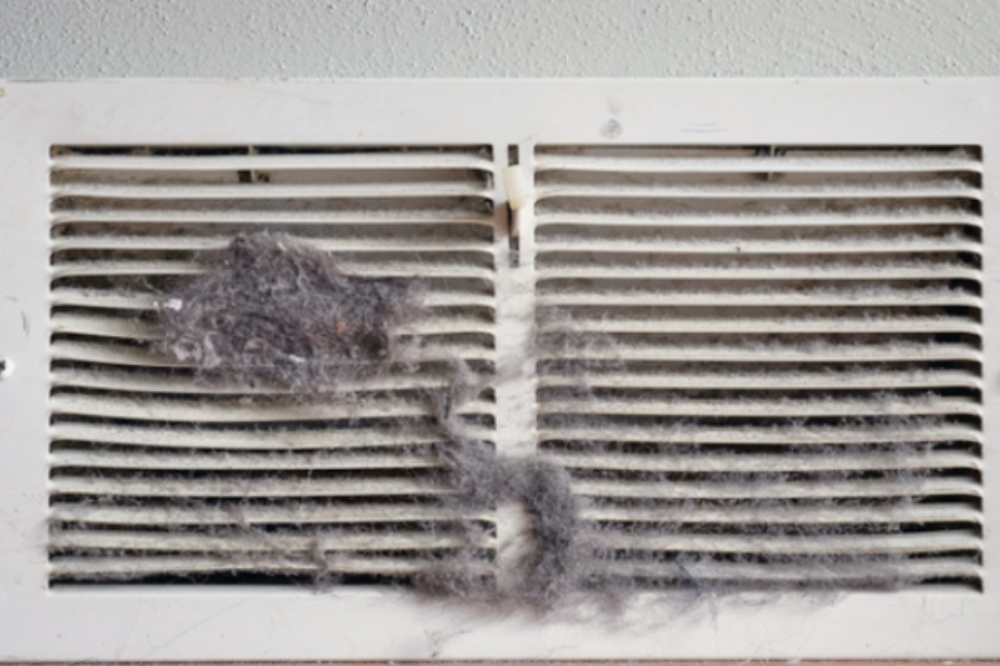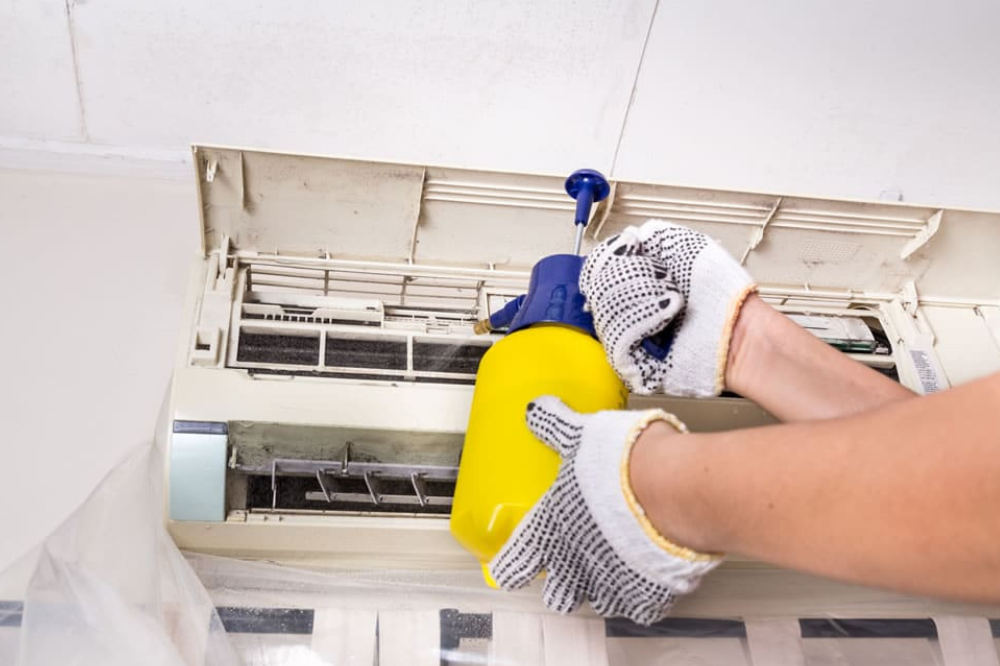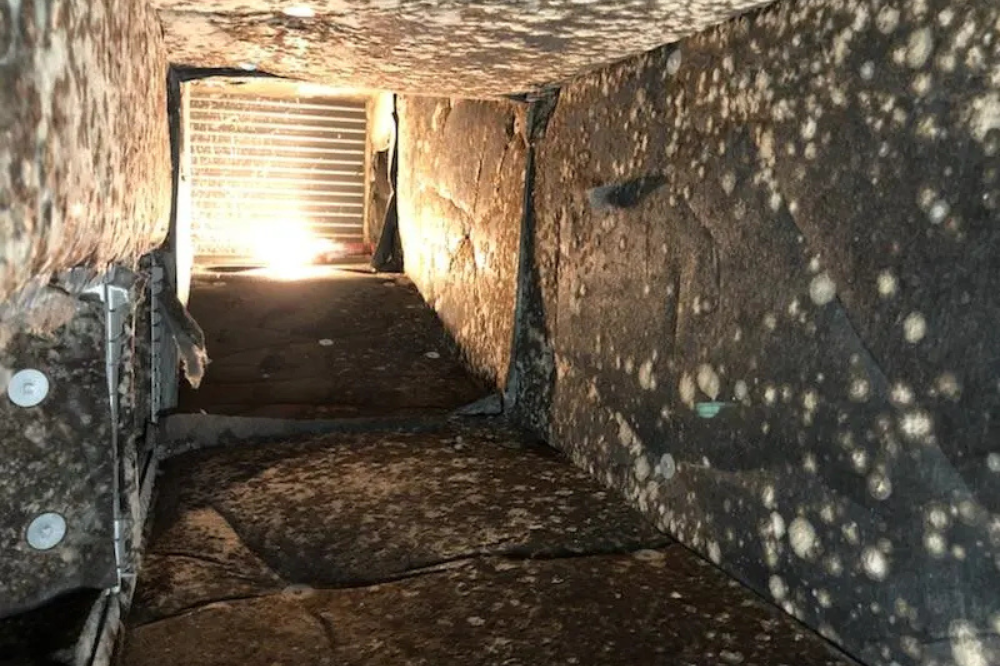Mold growth in HVAC systems is a common problem that can compromise indoor air quality and lead to potential health risks. HVAC systems provide an ideal environment for mold growth due to moisture and organic material present in the ducts and components.
It is crucial to take prompt action to prevent mold growth and address contamination in HVAC systems before it spreads and causes severe damage or poses severe health risks. This article will provide an in-depth overview of the risks associated with mold in HVAC systems and the importance of prevention and timely removal.
Key Takeaways:
- Mold growth in HVAC systems can compromise indoor air quality and pose potential health risks.
- Preventing mold growth and addressing contamination in HVAC systems is crucial to prevent damage and costly repairs.
- Regular HVAC maintenance, controlling humidity levels, and ensuring proper ventilation can prevent mold growth in HVAC systems.
- Professional mold inspections and remediation services are crucial to identify hidden mold and ensure safe and effective removal.
- Addressing mold growth in HVAC systems promptly can prevent further damage and protect indoor air quality and health.
Understanding Mold in HVAC Systems
Mold growth in HVAC systems can be a common problem, causing not only damage to the system itself but also posing health risks to those who inhabit the building. Understanding how mold develops and thrives in HVAC systems is crucial for prevention and effective remediation.
Mold requires three things to grow: a food source, moisture, and the right temperature. HVAC systems can provide an ideal environment for mold growth, as they often provide a food source in the form of organic material, such as dirt, debris, or pollen. Moisture is also a critical factor, with HVAC systems providing ample humidity through condensation around coils and ducts or poor ventilation. Finally, HVAC systems can maintain a consistent temperature, which is often optimal for mold growth.
Once mold begins to grow in an HVAC system, it can quickly spread throughout the entire system. Mold spores can move through the ductwork and contaminate the air circulating throughout the building, potentially impacting indoor air quality and leading to health problems in inhabitants.
To understand how mold grows in HVAC systems, consider the following factors:
| Factors Contributing to Mold Growth in HVAC Systems | Description |
|---|---|
| Poor Ventilation | When HVAC systems do not receive adequate ventilation, humidity and moisture can accumulate, leading to mold growth. |
| Moisture | Mold requires moisture to grow, and HVAC systems can provide plenty of it through condensation around coils and ducts or stagnating water. |
| Organic Material | HVAC systems can provide an ideal environment for mold growth with dirt, debris, and pollen as the prime food source. |
| Temperature | HVAC systems can maintain consistent temperatures, and some molds thrive in warmer temperatures, making it an ideal environment for mold growth. |
The key to addressing mold growth in HVAC systems is prevention. Regular maintenance, timely repairs, and controlling humidity levels can help prevent the conditions that facilitate mold growth. In the event of mold contamination, prompt remediation is crucial to minimize the risk of health effects and prevent further damage to the system.
Health Risks Associated with HVAC Mold
Mold in HVAC systems can pose serious health risks to individuals in the building. When mold spores are released into the air, they can be inhaled and cause a range of respiratory issues, allergies, and other health problems.
Research has shown that exposure to mold can aggravate asthma and other respiratory conditions. It can also cause coughing, sneezing, nasal congestion, skin irritation, and eye irritation. In some cases, individuals may experience more severe reactions, such as fever and difficulty breathing.
It’s important to address mold growth in HVAC systems to protect the health of those who occupy the building. Neglecting the issue can lead to prolonged exposure to mold spores and an increased risk of health problems.
Don’t wait until it’s too late to address the mold in your HVAC system. Your health could depend on it.
Indicators of Mold Exposure
Individuals who have been exposed to mold in HVAC systems may experience a range of symptoms. Some of the most common indicators of mold exposure include:
| Symptoms | Description |
|---|---|
| Musty Odors | An unpleasant, earthy smell coming from the vents |
| Allergic Reactions | Sneezing, coughing, congestion, skin irritation, and eye irritation |
| Visible Mold Growth | Black or greenish-brown clusters of mold around the HVAC system |
| Frequent Illness | Recurrent respiratory infections or flu-like symptoms |
If you’ve noticed any of these indicators, it’s important to have your HVAC system inspected for mold growth.
Signs of Mold in HVAC Systems
Mold in HVAC systems can spread quickly and impact the health of occupants. It’s crucial to recognize the signs to avoid further contamination and damage. The following are common indicators of mold growth in HVAC systems:
- Musty Odors: Unpleasant smells that resemble dampness, especially when the HVAC system is running.
- Visible Mold Growth: Dark or discolored patches of mold on HVAC components, such as ducts, vents, or coils.
- Allergic Reactions: Symptoms like itchy eyes, sneezing, coughing, or throat irritation that worsen indoors and improve outdoors.
If you suspect mold in your HVAC system, take immediate action. Contact a mold remediation specialist to assess the situation and address any contamination. Timely intervention can prevent further health risks and damage to the HVAC system.

Mold Prevention in HVAC Systems
To prevent mold growth in HVAC systems, regular maintenance is essential. Dirty filters, clogged ducts, and poorly functioning HVAC equipment can harbor moisture and promote microbial growth. Routine inspections can detect early signs of mold and prevent contamination from spreading.
Controlling humidity levels can also discourage mold growth. Keeping the relative humidity below 60% can inhibit microbial growth and reduce the risk of condensation forming on HVAC components. Installing a dehumidifier may be necessary in humid climates to maintain consistently low humidity levels.
Proper ventilation is also crucial to reduce moisture buildup and stagnant air. Duct cleaning can prevent the accumulation of dust and organic material that can create an environment conducive to mold growth. HVAC professionals can provide advice on how to maintain adequate air circulation throughout the building.
“Mold can cause significant damage to the HVAC system and serious health risks if left unchecked. Regular HVAC maintenance, humidity control, and proper ventilation can help prevent the buildup of moisture and organic material that contribute to mold growth.”
Mold Removal in HVAC Systems
Mold remediation in HVAC systems is a critical process that should be handled by professionals to ensure safe and effective removal. The first step is to locate the source of the mold growth, which is often found in ducts, coils, and other components of the system. Once the source is identified, remediation experts will create a plan for removing the mold and preventing its return.
The process typically involves the following steps:
| Step | Description |
|---|---|
| Assessment | Experts will assess the extent of the mold contamination and develop a plan for remediation. |
| Containment | The affected area will be sealed off to prevent the spread of mold spores to other parts of the building. |
| Removal | Mold in the HVAC system will be removed using specialized tools and techniques, with care taken not to spread spores. |
| Cleanup | The area will be thoroughly cleaned to remove any remaining mold spores and debris. |
| Testing | The air quality will be tested to ensure that the mold has been effectively removed and will not return. |
The cost of mold remediation in HVAC systems can vary depending on the extent of the contamination and the complexity of the removal process. However, it’s important to note that the potential costs and health risks of not addressing the issue far outweigh the investment in professional remediation.
If you suspect mold growth in your HVAC system, it’s important to take immediate action and contact a professional for mold removal and remediation.
DIY Mold Prevention Tips for HVAC Systems
Mold prevention in HVAC systems is possible with a little effort and regular maintenance. By taking proactive measures to prevent mold growth, you can save yourself from the hassle and potential health risks associated with mold contamination. Here are some practical DIY tips to keep your HVAC system mold-free:
| Action | Description |
|---|---|
| Change Filters Regularly | Dirty filters can become a breeding ground for mold. Regularly changing your filters can prevent mold growth by improving air flow and filtration. |
| Clean Ducts | Ducts can accumulate dirt, debris, and moisture, creating a perfect environment for mold growth. Regularly cleaning your ducts can eliminate these factors and prevent mold contamination. |
| Control Humidity Levels | Mold thrives in moisture-rich environments. Using a dehumidifier or air conditioner can help to control humidity levels and prevent mold growth. |
| Ensure Proper Ventilation | Inadequate ventilation can create stagnant air that promotes mold growth. Make sure your HVAC system provides proper ventilation to maintain good air quality and prevent mold. |
| Use UV Lights | Installing UV lights in your HVAC system can help to kill mold spores and prevent further growth. However, it’s important to note that UV lights are not a guaranteed solution and should be used in conjunction with other preventative measures. |

By following these DIY tips for mold prevention in your HVAC system, you can take control of your indoor air quality and ensure a safe and healthy environment for you and your family. However, if you suspect mold contamination or require professional assistance, don’t hesitate to contact a reputable HVAC specialist.
Professional HVAC Mold Inspection
Mold growth in HVAC systems can be insidious and difficult to detect. A visual inspection can only reveal so much. That’s why it’s important to have your HVAC system inspected by professionals.
Expert inspectors have the training, experience, and equipment to properly assess the severity of mold contamination and identify hidden mold growth in your HVAC system. They can take air samples to determine the concentration of mold spores and assess the indoor air quality of your home or business.
Based on their findings, professional inspectors can provide recommendations for remediation and mold prevention measures. This can help you avoid future mold growth and ensure that your HVAC system is clean and functioning optimally.
The Benefits of Professional HVAC Mold Inspection
| Benefits | Description |
|---|---|
| Early Detection | A professional inspection can identify mold growth early, preventing it from spreading and causing further damage. |
| Thorough Diagnosis | Expert inspectors can determine the type and severity of mold contamination, as well as any underlying causes. |
| Safe and Effective Remediation | Professional inspectors can provide recommendations for mold remediation measures that are safe and effective. |
| Improved Indoor Air Quality | By identifying and addressing mold growth in your HVAC system, you can improve the air quality in your home or business, protecting the health of occupants. |
Don’t wait until mold growth causes health problems or extensive damage to your HVAC system. Schedule a professional HVAC mold inspection today to ensure the safety and efficiency of your heating and cooling system.
Importance of Timely HVAC Mold Remediation
Mold growth in HVAC systems is a serious matter that should not be ignored. The longer mold is left untreated, the greater the damage it can cause to your HVAC system. Mold can lead to clogs, corrosion, and reduced efficiency, leading to costly repairs or even replacement. It is crucial to address mold contamination in your HVAC system promptly to prevent further damage.
Not only can mold damage your HVAC system, but it can also impact your health. Mold spores can aggravate allergies and lead to respiratory issues, especially in individuals with compromised immune systems. Mold remediation in HVAC systems can help keep your system running smoothly and ensure the air circulating in your home or office is clean and healthy.
Professional mold remediation services should be sought out as soon as any mold contamination is detected to prevent further damage. Attempting to remove the mold yourself can cause the spores to spread, leading to bigger problems. Qualified professionals use specialized equipment and techniques to safely and effectively remove mold from HVAC systems.
Conclusion
Mold growth in HVAC systems poses a significant health risk to building occupants and can cause costly damage to HVAC components. This article has highlighted the importance of understanding how mold can develop in these systems and take steps to prevent its growth. It has also emphasized the need for timely mold removal by professionals to keep building occupants safe and prevent further damage.
Regular HVAC maintenance, controlling humidity levels, and ensuring proper ventilation are all effective ways to prevent mold growth. DIY strategies such as filter changes, duct cleaning, and UV lights can also be helpful. However, it is essential to hire professionals for thorough inspections and safe and effective mold removal.
Don’t wait until it’s too late. Take action now to prevent mold growth in your HVAC system and protect the health of building occupants.
FAQ
What are the risks associated with mold in HVAC systems?
Mold in HVAC systems can pose several risks. It can negatively impact indoor air quality, causing respiratory issues, allergies, and other health problems. Mold can also damage HVAC components, leading to clogs, corrosion, reduced efficiency, and costly repairs.
How does mold develop and thrive in HVAC systems?
Mold in HVAC systems thrives in environments with moisture, poor ventilation, and organic material. These factors create the perfect conditions for mold spores to grow and spread. Mold can develop on HVAC coils, ducts, and other components, and then circulate throughout the system, affecting the entire indoor space.
What are the potential health risks of mold in HVAC systems?
Mold in HVAC systems can release mold spores into the air, which can be inhaled by occupants. This can lead to respiratory issues, allergies, and other health problems, particularly in individuals with pre-existing respiratory conditions or weakened immune systems. Timely removal of mold is essential to protect the health of occupants.
How can I recognize the presence of mold in my HVAC system?
Signs of mold in HVAC systems include musty odors, visible mold growth on ducts or other components, and experiencing allergic reactions when the system is running. If you suspect mold in your HVAC system, it’s important to take prompt action to address the issue and prevent further contamination.
What can I do to prevent mold growth in my HVAC system?
To prevent mold growth in your HVAC system, ensure proper ventilation, control humidity levels, and perform regular maintenance. Change air filters regularly, clean ducts and coils, and consider using UV lights to inhibit mold growth. These proactive measures can help create an environment that discourages mold growth.
How is mold removed from HVAC systems?
Mold removal in HVAC systems typically involves hiring professionals who specialize in mold remediation. They will assess the severity of contamination, safely remove the mold, and clean and disinfect the affected components. It’s important to hire experts for effective and thorough mold removal to ensure the safety of occupants and prevent further contamination.
Are there any DIY tips for preventing mold growth in HVAC systems?
Yes, there are DIY tips for preventing mold growth in HVAC systems. Regularly change air filters, clean ducts and coils, and consider using UV lights to inhibit mold growth. However, it’s crucial to note that DIY prevention is not a substitute for professional HVAC maintenance and inspections.
Why is professional HVAC mold inspection important?
Professional HVAC mold inspection is crucial because experts can identify hidden mold growth, assess the severity of contamination, and provide recommendations for effective remediation. They have the knowledge, equipment, and expertise to thoroughly inspect your HVAC system and ensure that no mold is left behind.
Why is timely HVAC mold remediation important?
Timely HVAC mold remediation is important because mold can cause significant damage to HVAC components. Mold can lead to clogs, corrosion, reduced efficiency, and costly repairs. By addressing mold promptly, you can prevent further damage to your HVAC system and maintain its optimal performance.
What is the importance of mold prevention and timely removal in HVAC systems?
Mold prevention and timely removal in HVAC systems are crucial for maintaining indoor air quality and protecting the health of occupants. They also help to prevent damage to HVAC components, ensuring the system’s efficiency and preventing costly repairs. Regular maintenance and professional assistance are key to preventing mold in HVAC systems.






